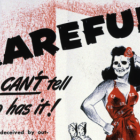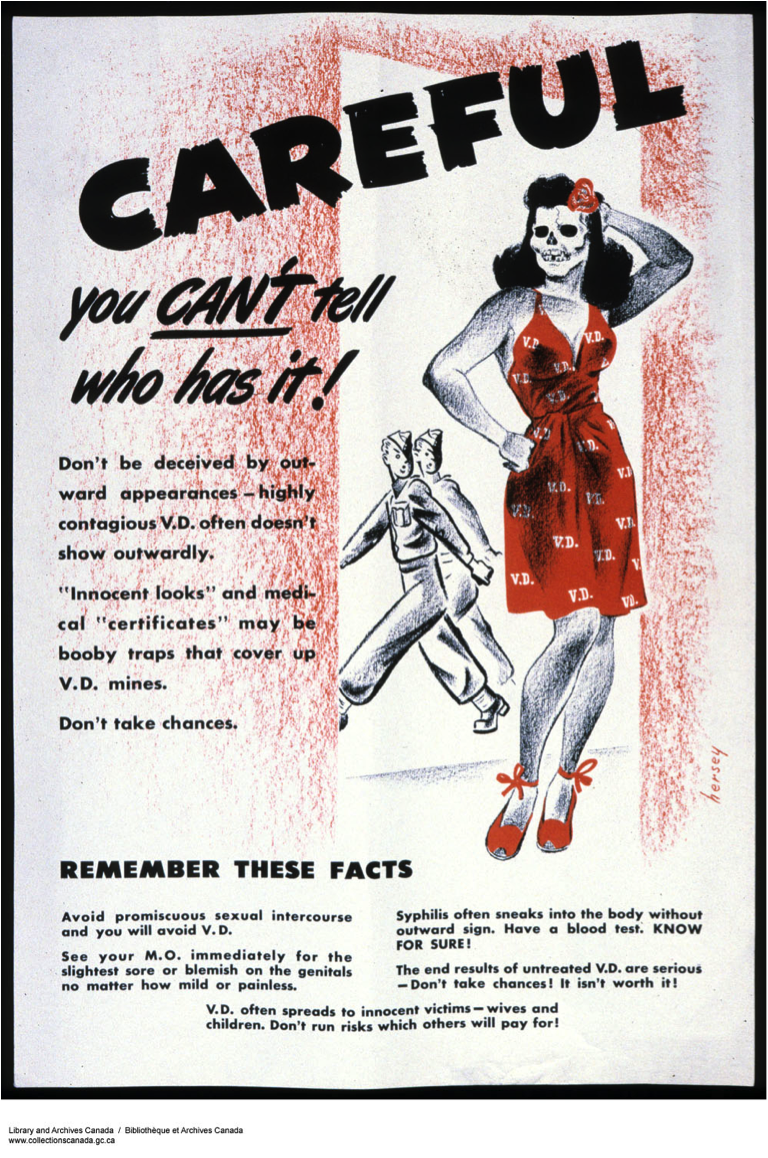
A poster in the campaign against venereal disease during the Second World War in Canada, directed towards soldiers. The messages that women and immoral behavior were to blame are still present.
A poster in the campaign against venereal disease during the Second World War in Canada, directed towards soldiers. The messages that women and immoral behavior were to blame are still present.
Harry Mayerovitch, Library and Archives Canada, Acc. No. 1985-111-4, Copyright: Expired
 This work is licensed under a Creative Commons Public Domain Mark 1.0 License.
This work is licensed under a Creative Commons Public Domain Mark 1.0 License.
Before the First World War, Canada was envisioned as a vast, unspoiled frontier wilderness—an environment lacking the crowded cities and unhealthy conditions of European cities. Settlers who lived within this rugged environment were thought of as strong, hardy hunters and natural sportsmen. When Canada began recruiting a civilian army in 1914, these ideas of place and environment were transferred to Canadian recruits. Recently historians Nic Clarke, Kris Inwood, and John Cranfield have challenged these “myths” about Canadian soldiers, which ignored the fact that most recruits were British-born, and that the crowded, urban slums of Canada’s major cities could compete with those in Britain.
As Tim Cook has shown, the propaganda machine worked efficiently throughout the war to build on the image of hardy Canadian soldiers from a rugged environment. Recruitment, however, revealed a different reality. On the home front in Canada, recruits were rejected in high numbers for diseases like tuberculosis and for psychiatric, musculoskeletal, and neurological disorders along with poor vision and dental health. Perhaps more shocking was the revelation that the Canadian Expeditionary Force (CEF) boasted one of the highest rates of venereal disease infection among the Allies.
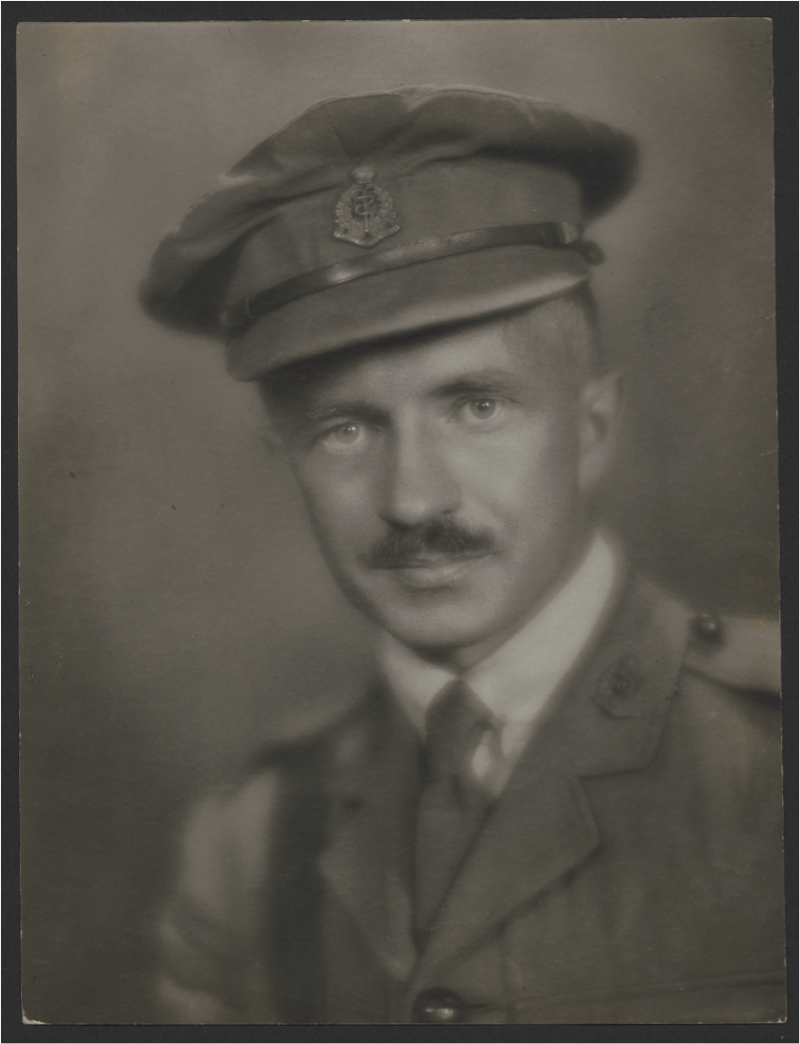
A photograph of Captain Gordon A. Bates (approx. age 33), who was in charge of the venereal ward at the Toronto Military Base Hospital during the latter half of the First World War. Bates’ fight against venereal diseases continued until his death in 1975. In one article, entitled “Dr. Gordon Bates: A Personal War against VD,” Bates was quoted as saying, “The venereal diseases, gonorrhea and syphilis are evidence of moral delinquency even though they result finally in sufferings to millions.”
A photograph of Captain Gordon A. Bates (approx. age 33), who was in charge of the venereal ward at the Toronto Military Base Hospital during the latter half of the First World War. Bates’ fight against venereal diseases continued until his death in 1975. In one article, entitled “Dr. Gordon Bates: A Personal War against VD,” Bates was quoted as saying, “The venereal diseases, gonorrhea and syphilis are evidence of moral delinquency even though they result finally in sufferings to millions.”
City of Toronto Archives, Fonds 70, Series 340, Subseries 6, File 3, 1914-1918, Reproduced with the permission of the City of Toronto Archives.
This work is used by permission of the copyright holder.
In the winter of 1914–15, among Canadian soldiers on Salisbury Plain, 222 per 1,000 per annum were reportedly infected with venereal disease. In contrast, among Australian troops in Britain, the rate of infection ranged between 134 and 148 per 1,000 per annum. While these rates are shocking, they occurred before any policy towards venereal disease had been developed in the British Army. Furthermore, it is difficult to compare rates between groups because it is unclear how rates of infection were obtained (for example, rates determined by a mandated physical inspection would be different than those obtained by self-reporting to medical officers).
Military officials realized that the problem of venereal disease was not limited to soldiers overseas, and that many volunteers had contracted their infections on the home front. This perhaps explains the vigor with which the venereal disease problem was dealt with in Canada. According to Dr. Gordon Bates, the medical officer in charge of the venereal ward at the Military Base Hospital in Toronto, about 1,500 soldiers were admitted each year to his hospital alone. It is not surprising therefore, that the Military Base Hospital in Toronto became a place synonymous with the treatment of venereal disease.
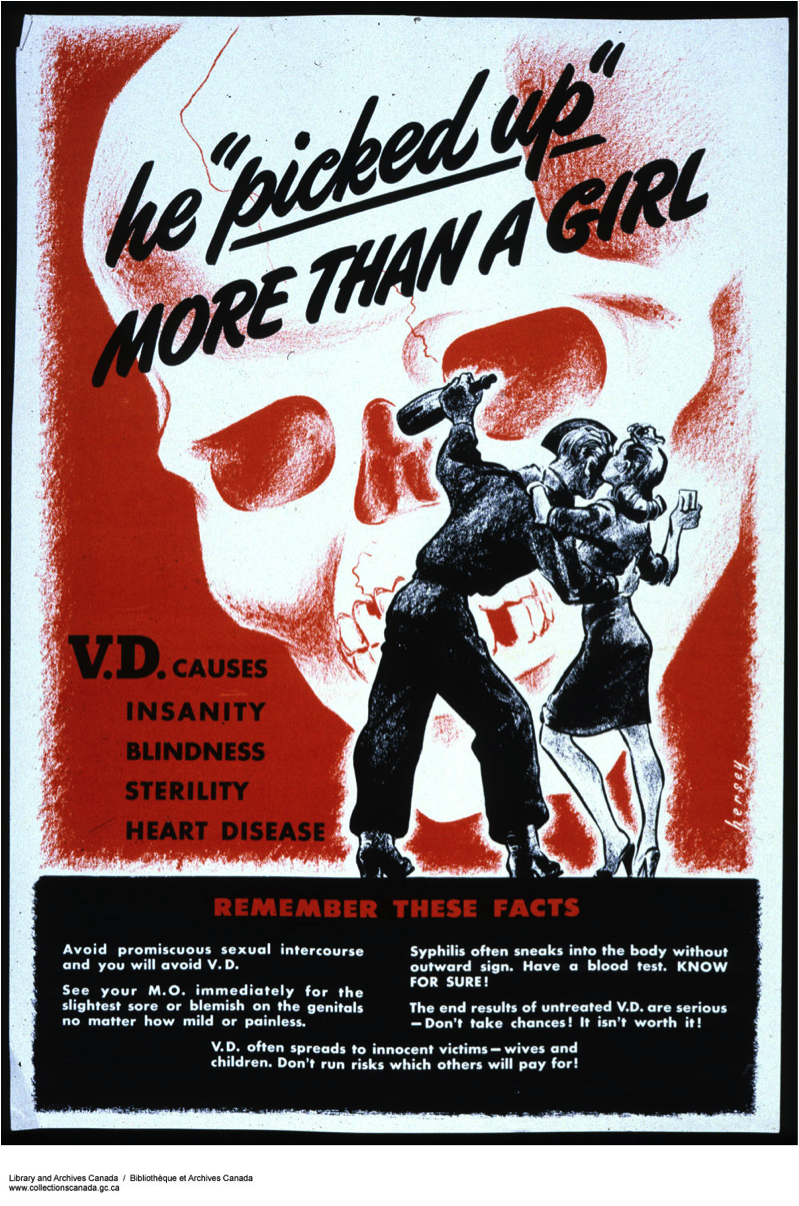
Another poster in the campaign against venereal disease during the Second World War—the problem did not go away after the First World War, and Canadians were again shocked at the high rates of venereal disease in the army.
Another poster in the campaign against venereal disease during the Second World War—the problem did not go away after the First World War, and Canadians were again shocked at the high rates of venereal disease in the army.
Harry Mayerovitch, Library and Archives Canada, Acc. No. 1985-35-8, Copyright: Expired.
 This work is licensed under a Creative Commons Public Domain Mark 1.0 License.
This work is licensed under a Creative Commons Public Domain Mark 1.0 License.
The major recognized venereal diseases, which we now call sexually transmitted infections (STIs), during the First World War were bacterial infections, namely syphilis, gonorrhea and chancroid. In Canada during the war, military medical officers examined soldiers for venereal disease at random, questioned them about the source of their infection, and held them in hospital until a cure was achieved. The venereal ward of the Military Base Hospital in Toronto was on the top floor of the hospital, and the windows and entrances to the ward were barred to prevent patients escaping. Patients were not allowed to have newspapers, or visitors, and they were not permitted outside of the venereal ward. Soldiers’ pay was stopped while they were being treated for venereal disease. None of these measures were medically necessary to achieve a cure, and each can be seen as punishment for crime of contracting venereal disease.
The venereal disease problem in the military highlights the divergence between reality and long-held ideas about people and place. Assumptions about Canada as a healthful, unmarred frontier environment and Canadian soldiers as healthy rugged frontiersmen contrast with the reality of widespread ill-health within the population that was revealed through the war effort.
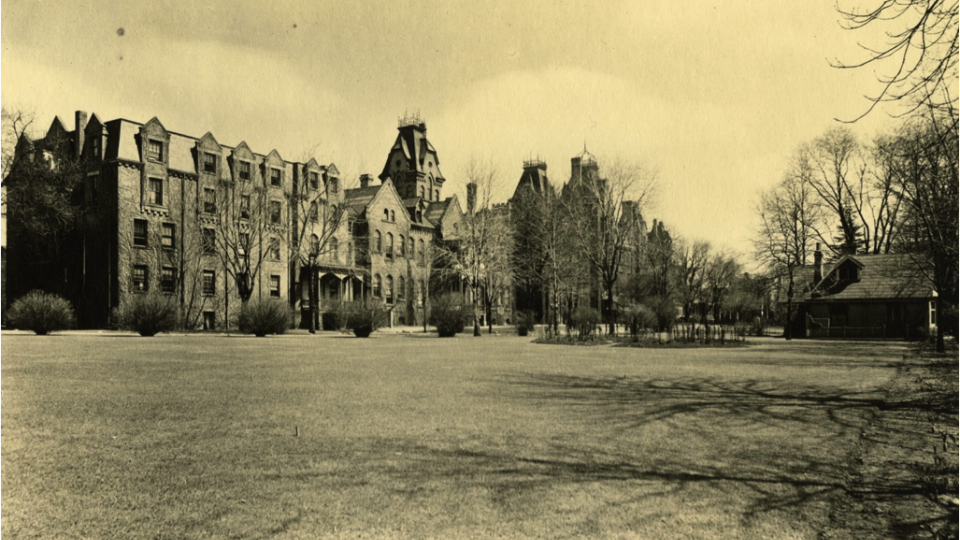
A photograph of the Toronto Military Base Hospital, formerly the Toronto General Hospital, on Gerrard St., Toronto, Ontario. Each ward was designed so that it could be shut off from the others, a feature that military officials used to segregate venereal patients. The venereal disease ward was on the top floor of this hospital.
A photograph of the Toronto Military Base Hospital, formerly the Toronto General Hospital, on Gerrard St., Toronto, Ontario. Each ward was designed so that it could be shut off from the others, a feature that military officials used to segregate venereal patients. The venereal disease ward was on the top floor of this hospital.
Toronto Public Library, Baldwin Collection, X 63-10, 1900, Image in the Public Domain.
 This work is licensed under a Creative Commons Public Domain Mark 1.0 License.
This work is licensed under a Creative Commons Public Domain Mark 1.0 License.
How to cite
Bogaert, Kandace. “Treating the ‘Undesirable’: Venereal Patients in the Canadian Expeditionary Force, 1914–1918.” Environment & Society Portal, Arcadia (Spring 2017), no. 2. Rachel Carson Center for Environment and Society. doi:10.5282/rcc/7743.
ISSN 2199-3408
Environment & Society Portal, Arcadia
 This work is licensed under a Creative Commons Attribution 4.0 International License.
This work is licensed under a Creative Commons Attribution 4.0 International License.
2017 Kandace Bogaert
This refers only to the text and does not include any image rights.
Please click on an image to view its individual rights status.
- Bates, Gordon. “The Control of Venereal Diseases.” The Public Health Journal 8, no. 8 (1917): 187–89.
- Beaton-Mamak, Mary. “Dr. Gordon Bates: A Personal War against VD.” Dimensions in Health Service. Profiles 52, no. 195 (1975): 16.
- Buckley, Suzann, and Janice Dickin McGinnis. “Venereal Disease and Public Health Reform in Canada.” Canadian Historical Review 63, no. 3 (1982): 337–54.
- Butler, Arthur Graham. “The Venereal Diseases of the War of 1914-18.” In Official History of the Australian Medical Services 1914-18. 1st ed., 148–89. Canberra: Australian War Memorial, 1943.
- Cassel, Jay. “Making Canada Safe for Sex: Government and the Problem of Sexually Transmitted Diseases in the Twentieth Century.” In Canadian Health Care and the State: A Century of Evolution, edited by D Naylor, 141–92. Kingston: McGill-Queen’s University Press, 1992.
- Clarke, Nic, Cranfield, John, and Inwood, Kris. “Fighting Fit? Diet, Disease, and Disability in the Canadian Expeditionary Force, 1914–18,” War and Society 33, no. 2 (2014): 80–97. doi:10.1179/0729247314Z.00000000033.
- Morton, Desmond. “Military Medicine and State Medicine: Historical Notes on the Canadian Army Medical Corps in the First World War 1914-1919.” In Canadian Health Care and the State, edited by David Naylor, 38–66. Montreal & Kingston: McGill Queens University Press, 1992.



